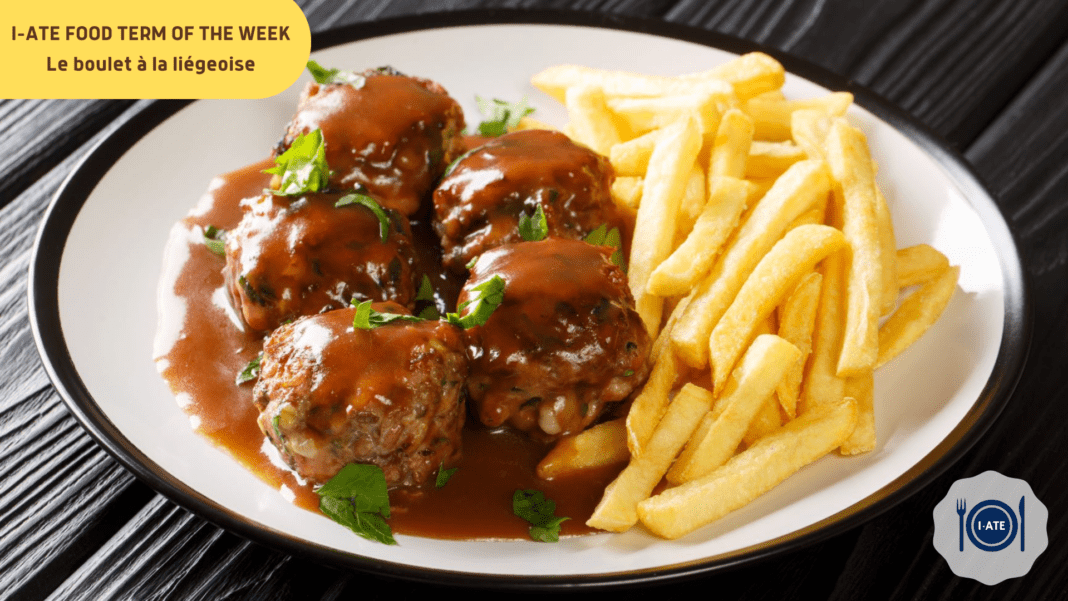Le boulet à la liégeoise (or boulet liégeois), is, like the name indicates, a meatball specialty from the region of Liège in Belgium. The meatball(s), made from minced beef and pork with shallots, parsley, marjoram, and breadcrumbs, are an immaterial cultural heritage of Belgium. The meatball is served in a sweet and sour sauce usually accompanied by fries, salad and/or apple compote.
The dish dates back to ancient times, and although it is very popular today, it has not always been. Only the wealthy people were able to afford the ingredients, such as meat and spices. The boulet is a great example of aristocratic gastronomy that has found its way into the popular cuisine over the path of the bourgeoisie.
In Europe the meatball is first found in medieval cookbooks of the 13th century. At first, they were sumptuous dishes of great refinement (e.g. served with a gold leaf for princely feasts in 14th century France). Belonging to haute cuisine, many diverse recipes based on minced meat became very fashionable. By the end of the Middle Ages meatballs had spread to Germany, England, Italy, and also Liège.
The term boulet, which originally referred to the cannonball, does not appear in the dictionary in a specifically culinary definition, but is first used in the 16th century by Lancelot de Casteau, master chef of three prince-bishops of Liege. In a collection of recipes published in 1604 boulet is used for a recipe with minced fish. An equivalent recipe with minced veal shaped into balls, uses the term rondes boules. In an 18th-century manuscript from Liège a similar recipe can be found, this time under the name of boulet, which is now the established term.
These meatball recipes are very similar to the ones used today, only the sauce has changed over the years. In 1604, the meatballs were served with a broth-based sauce, flavoured with lemon and herbs. In the 19th and 20th centuries the meatball was democratised and served either in a sauce piquante made with vinegar or in a tomato sauce, but could also simply be eaten cold without any sauce.
What is known today as le boulet à la liégeoise is a meatball served with sauce lapin. This sweet-sour sauce is prepared with caramelized onions, thyme, bay leaves, cloves, brown sugar, wine vinegar, meat stock, real Sirop de Liège [1], and bound either with corn starch or a butter-flour mixture.

It is only in the 1980s when lovers of folklore took interest in the recipe, which was available in all brasseries and friteries, that the dish was included in the official Liège cuisine and the boulet sauce lapin gradually took the name of boulet à la liégeoise.
On 23 March 1996 a brotherhood was founded with the goal to make the boulet à la liégeoise known in the world and to defend its artisanal quality. La Confrérie du Gay Boulet has drawn up a list of establishments, inspired by gastronomical guides, which serve this typical dish. In addition, each year they award a trophy called the Boulet de Cristal to the restaurant owner whose recipe is closest to the local tradition.
[1] Sirop de Liège is a kind of thick, black molasses with a firm texture, obtained after cooking and reducing concentrated apple and/or pear juice and sometimes date juice.
References:
Boulettes Magazine. 2019. 5 infos que vous ignoriez sur les bouletsà la liégeoise, Boulettes Magazine, [online] Available at: https://www.boulettesmagazine.be/5-infos-que-vous-ignoriez-sur-les-boulets-a-la-liegeoise/. [Accessed 07 June 2022].
Confrérie du Gay Boulet. n.d.. Présentation de la Confrérie, [online] Available at: http://www.gayboulet.be/crbst_3.html. [Accessed 07 June 2022].
CuisineAZ.com. 2019. Sirop de Liège, Cuisine AZ, [online] Available at: https://www.cuisineaz.com/articles/sirop-de-liege-2945.aspx. [Accessed 07 June 2022].
Florence. 2021. Les boulettes liégeoises et leur fameuse sauce lapin, Vivre à Bruxelles, [online] Available at: https://vivreabruxelles.be/les-boulettes-liegeoises-et-leur-fameuse-sauce-lapin.html. [Accessed 07 June 2022].
Patrimoine vivant Wallonie-Bruxelles. n.d.. Le boulet à la liégeoise, [online] Available at: http://www.patrimoinevivantwalloniebruxelles.be/patrimoines/pratiques/fiche_pratiques/?n=8. [Accessed 07 June 2022].
ULiège. n.d.. Le boulet liégeois, [online] Available at: https://www.news.uliege.be/cms/c_10915922/fr/le-boulet-liegeois. [Accessed 07 June 2022].

Written by Bea Schlembach.
Bea is currently a master’s student in “Learning and Communication in Multilingual and Multicultural Contexts” at the University of Luxembourg and is completing a study visit at the European Parliament.

